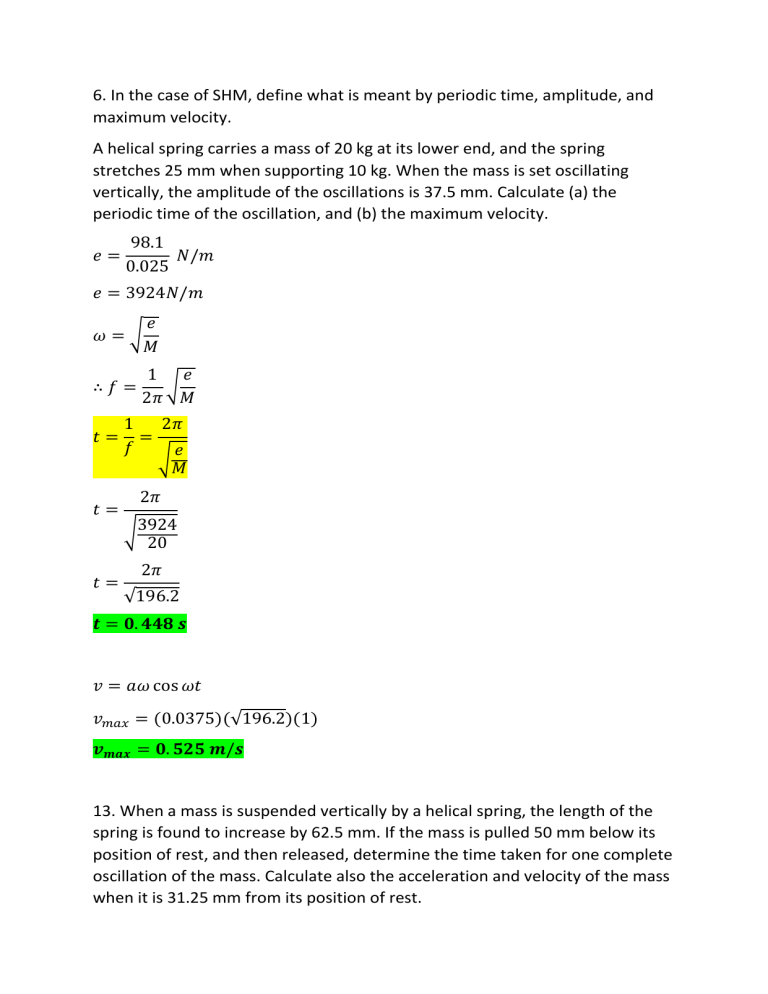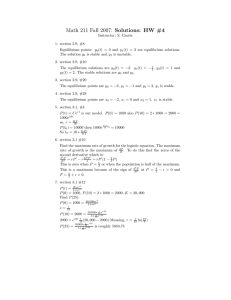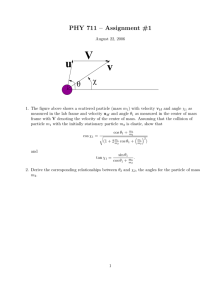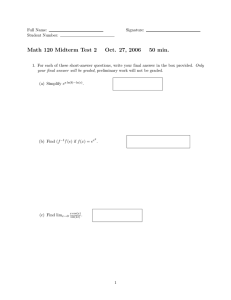
6. In the case of SHM, define what is meant by periodic time, amplitude, and maximum velocity. A helical spring carries a mass of 20 kg at its lower end, and the spring stretches 25 mm when supporting 10 kg. When the mass is set oscillating vertically, the amplitude of the oscillations is 37.5 mm. Calculate (a) the periodic time of the oscillation, and (b) the maximum velocity. 𝑒= 98.1 𝑁/𝑚 0.025 𝑒 = 3924𝑁/𝑚 𝜔=√ ∴𝑓= 𝑡= 𝑡= 𝑡= 𝑒 𝑀 1 𝑒 √ 2𝜋 𝑀 1 2𝜋 = 𝑓 𝑒 √ 𝑀 2𝜋 √3924 20 2𝜋 √196.2 𝒕 = 𝟎. 𝟒𝟒𝟖 𝒔 𝑣 = 𝑎𝜔 cos 𝜔𝑡 𝑣𝑚𝑎𝑥 = (0.0375)(√196.2)(1) 𝒗𝒎𝒂𝒙 = 𝟎. 𝟓𝟐𝟓 𝒎/𝒔 13. When a mass is suspended vertically by a helical spring, the length of the spring is found to increase by 62.5 mm. If the mass is pulled 50 mm below its position of rest, and then released, determine the time taken for one complete oscillation of the mass. Calculate also the acceleration and velocity of the mass when it is 31.25 mm from its position of rest. 𝑒= 𝑀 × 9.81 𝑁/𝑚 0.0625 𝑀 × 9.81 𝑀 × 9.81 √ 0.0625 𝜔= =√ 𝑀 0.0625 × 𝑀 9.81 𝜔=√ 0.0625 𝑡= 𝑡= 1 2𝜋 = 𝑓 𝜔 2𝜋 √ 9.81 0.0625 𝒕 = 𝟎. 𝟓𝟎𝟏 𝒔 𝑥 = 𝑎 sin 𝜔𝑡 0.03125 = 0.05 sin 𝜔𝑡 0.625 = sin 𝜔𝑡 cos 𝜔𝑡 = √1 − (0.625)2 cos 𝜔𝑡 = √0.609375 cos 𝜔𝑡 = 0.781 𝑣 = 𝑎𝜔 cos 𝜔𝑡 9.81 𝑣 = (0.05)(√ )(0.781) 0.0625 𝑣 = (0.05)(12.528)(0.781) 𝒗 = 𝟎. 𝟒𝟖𝟗 𝒎/𝒔 𝑎𝑐𝑐𝑒𝑙𝑒𝑟𝑎𝑡𝑖𝑜𝑛 = −𝜔2 . 𝑥 𝑎𝑐𝑐𝑒𝑙𝑒𝑟𝑎𝑡𝑖𝑜𝑛 = −(12.528)2 (0.03125) 𝒂𝒄𝒄𝒆𝒍𝒆𝒓𝒂𝒕𝒊𝒐𝒏 = − 𝟒. 𝟗 𝒎/𝒔𝟐 16. a) A mass is suspended from the end of a spring and caused to vibrate. Show that its motion satisfies your definition of simple harmonic motion. b) A particle, mass 0.34 kg, vibrates with simple harmonic motion of amplitude 50 mm. The maximum accelerating force acting on the particle is 18 N. Determine (i) the frequency of vibration, (ii) the maximum velocity of the particle, and (iii) the acceleration at 12.5 mm from the mean position. Frequency = 5.18 hz Velocity = 1.625 m/s Acceleration = 13.24 m/s2




